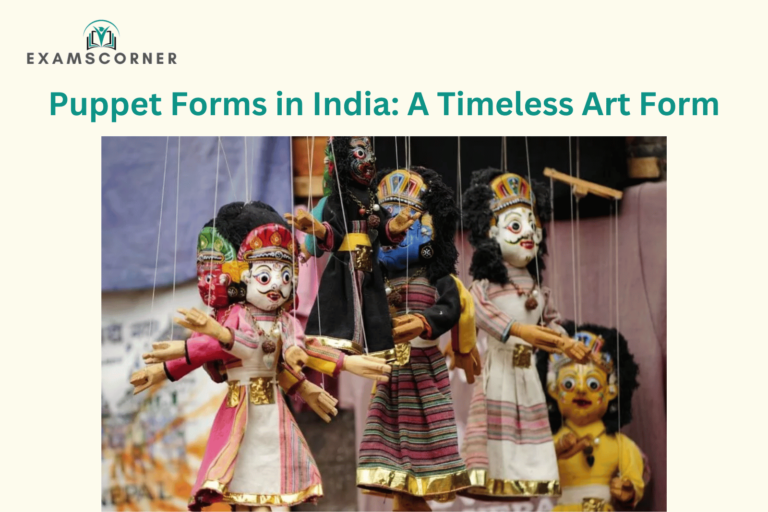Puppetry has been a significant part of traditional entertainment in India, holding a mirror to the country’s rich cultural heritage. Like traditional theatre, puppet theatre often draws its themes from epics and legends, presenting them through captivating performances. Each region in India boasts its unique style of puppetry, reflecting local painting and sculptural traditions.
What Are Puppets?
A puppet is a doll or figure manipulated by a person to give the appearance of independent movement. Puppetry is an ancient art form used to narrate stories, entertain, and impart moral lessons.
Types of Puppets in India
India is home to four major types of puppets, each with its own regional and cultural identity:
1. Glove Puppets
These puppets are worn like gloves and operated by the fingers and hands of the puppeteer.
- Key Types and Regions:
- Pava Koothu – Kerala
- Sakhi Kundhei Nata – Orissa
- Beni Putul – Bengal
2. Rod Puppets
Rod puppets are larger and supported by rods from below. They allow for elaborate movements.
- Key Types and Regions:
- Putul Nach – West Bengal
- Kathi Kandhe – Orissa
- Yampuri – Bihar
3. Shadow Puppets
These puppets are flat and operated behind a screen with a light source creating silhouettes.
- Key Types and Regions:
- Tholu Bommalata – Andhra Pradesh
- Togalu Gombeyata – Karnataka
- Tolpavakoothu – Kerala
- Chamadyache Bahulya – Maharashtra
- Ravanachhaya – Orissa
- Thol Bommalattam – Tamil Nadu
4. String Puppets
String puppets are controlled by strings attached to various parts of the puppet’s body, allowing intricate movements.
- Key Types and Regions:
- Putal Nach – Assam
- Gombeyatta – Karnataka
- Kalasutri Bahulya – Maharashtra
- Gopalila Kundhei – Orissa
- Kathputli – Rajasthan
- Bommalattam – Tamil Nadu
The Decline of Puppetry in India
Despite its historical significance, puppetry as an art form faces challenges in modern times.
Reasons for Its Decline:
- Lack of Patronage:
- Traditional patronage for puppetry has dwindled in the modern era.
- Competition from Electronic Media:
- Mythological stories like the Ramayana and Mahabharata are now more accessible through television and digital platforms, which are more appealing to audiences.
- Limited Scope of Themes:
- Puppetry remains confined to devotional and mythological stories, failing to address contemporary social issues.
- Lack of Modernization:
- Puppetry has not kept pace with advancements in scriptwriting, lighting, sound, and stage effects.
Origins of Puppetry
Puppetry is an ancient art form, believed to be over 3,000 years old.
- Earliest Puppets:
- Likely originated in Egypt, where puppets made of ivory and clay have been discovered in tombs.
- Historical Mentions:
- Ancient Greek scholars like Aristotle and Plato referenced puppets as early as 422 B.C.
Conclusion
Puppetry in India is a unique blend of art, storytelling, and tradition. While the art form faces challenges in the modern era, it remains a vital part of India’s cultural heritage. To revive puppetry, efforts must focus on incorporating modern themes, technology, and innovations while preserving its traditional essence.
By bringing puppetry into contemporary relevance, we can ensure this ancient art form continues to captivate audiences for generations to come.



